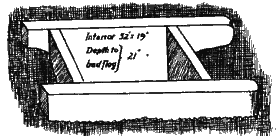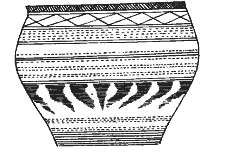
[from Proc IoMNH&ASoc vol2 #3 1917-1923]
Rev. Canon QUINE, M.A.
A fine cist, complete with the exception of the lid slab, was discovered in January, 1919, by Mr. Jno. F. Cowley of Baroose, Lonan, during the ploughing of a field behind Baroose Cottages, about 80 yards to the left of the high road 4.3 miles out from Douglas to Laxey. The upper edges of the cist were about nine inches below the surface, the lid slab having evidently been removed, and the cist chamber filled with a crush of surface soil, resulting in the breaking of the urn, many years ago,

(i) The cist was formed with bed slab, two long side slabs, and transverse end slabs neatly fitted, so that the ends of the side slabs projected from six inches to a foot beyond these transoms. The interior dimensions were: .32 inches long, 19 inches wide, and 21 inches deep; the axial direction of the chamber' being from N.W. to S.E. Note that the proportion of length to breadth is 5 to 3. The side slab showed an -upper edge 5 inches wide, thinning to 4 inches, its total length 49 inches. The other was of uniform thickness 2 inches, and of total length 54 inches. The transoms were respectively 2¾ inches and 2½ inches thick. The slabs were of blue slate, evidently quarried in the neighbourhood from surface beds. The general character of the work was neat and exact in adjustment, quite in contrast to some ruder and rather larger cists found elsewhere in the parish of Lonan, e.g., that at Clay Head. No trace of the' lid 'slab was discoverable in any of the field fences, but about 400 yards off, at the side of a ruined cottage, is a slab of corresponding size, worn very smooth on one side, seemingly from having been used as a door-step stone, or possibly as a floor flag. All the slabs of the cist, after measurement, were removed for safety to the adjoining field fence.

(ii) The urn, already broken before its discovery, was found in fragments, 44 in all; some of these immediately rescued by Mr. J. F. Cowley, and the rest secured after careful search by Mr. Jno. Kelly, of Wood Glen, who assisted Mr. Cowley in opening the cist. They also found quantities of charcoal, implying cremation on the spot, when the cist was constructed; and two flints, one a small, rude scraper, the other a slightly-chipped nodule. No other flints were discoverable on the surface of the field, but three-quarters of a mile nearly due south from the spot, a very large collection of flints was made in 1914, in a field on Baldroma, these now in the possession of Canon Quine, who joined Mr, Kelly and Mr, Cowley immediately after the cist was discovered.
(iii) The urn was practically reconstructed from the fragments rescued, quite sufficiently to admit of its form, size, and ornamentation being reduced to a measured drawing. The urn is of the kind known as 'beaker.' The diameter of the mouth was about 5 inches, of the base 3¼ inches, and the vertical depth 6 inches. It consisted of a black core of gritty pottery, well baked„ containing many small white fragments of crushed quartz. Over this. core had been laid on, both internally and externally, a thin layer of bright red clay. On this, externally, when in a soft state, the ornamentation had been 'incised ' or punctured, seemingly with flint gravers ; the whole then burnt again to a hard And very durable consistency. This is our first example of a 'beaker,'
(iv) The ornamentation is a design of five pairs of,parallel lines, with four bands of punctured ornament between them. Above this the lip of the urn was ornamented outside and inside, while below the five bands of ornament was a broader band of triangles with the vertex downwards. Around the base were six parallel lines.
The site is at the south end of a ridge, about 360 feet above sea level, on which there has been a large prehistoric work, the remains of which, in the form of large inscribed stones, have been collected by Mr. J. F. Cowley and Mr. Jno Kelly. Of these stones, with 'rock scribings,' nearly twenty have been secured, all of them of a granitic or gneiss rock, quite distinct from the slate slabs used in the construction of the cist. One of these large inscribed stones, subsequently unearthed by Mr. Cowley on the ridge about 40 yards from the Gist site, seems to indicate that the camp or earthworks was situated on the ridge; but centuries of agricultural routine quite sufficiently account for its complete obliteration; as also for the destruction of a mound. It is possible that a mound formerly covered the cist, this type however not the same as that opened in a mound on Gretch Veg, some twenty years ago.
N.B.-The illustration is from a first sketch; but the 'beaker ' 'is taller and not with contracted top as in the illustration.
|
|
||
| |
||
|
|
||
| Any comments, errors or omissions gratefully received MNB
Editor HTML Transcription © F.Coakley , 2008 |
||